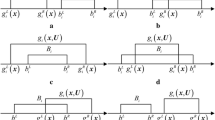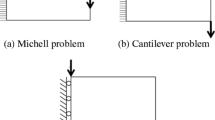Abstract
Civil engineering is a field – as are many other engineering sciences – where most of the methods used for solving optimization problems are based on experience and experiments, and models using local information, but drawn from global models. The present work outlines an interesting class of problems from this field, and initiates some possible ways to solve those problems utilizing the wide tool capabilities of interval arithmetic for error handling and interval branch-and-bound algorithms to solve the original or modified industrial models automating civil engineers' work. The investigations are in the first state but are promising both in a theoretical and in a practical sense.
Similar content being viewed by others
References
A.E. Csallner, Global optimization in separation network synthesis, Hungarian J. Industrial Chem. 21 (1993) 303–308.
T. Csendes, Z.B. Zabinsky and B.P. Kristinsdottir, Constructing large feasible suboptimal intervals for constrained nonlinear optimization, Ann. Oper. Res. 58 (1995) 279–293.
T. Csendes, Optimization methods for process network synthesis–a case study, in: Global and Multiple Criteria Optimization and Information Systems Quality, eds. C. Carlsson and I. Eriksson (Abo Academy, Turku, 1998) pp. 113–132.
T. Gyengő, Vasbeton Szerkezetek Elmélete, Méretezése és Szerkezeti Kialakítása (in Hungarian: The Theory, Design and Structural Shaping of Reinforced Concrete Structures) (Műszaki Könyvkiadó, Budapest, 1960).
B.P. Kristinsdottir, Z.B. Zabinsky, T. Csendes and M.E. Tuttle, Methodologies for tolerance intervals, Interval Comput. 3 (1993) 133–147.
B.P. Kristinsdottir, Z.B. Zabinsky, M.E. Tuttle and T. Csendes: Incorporating manufacturing tolerances in optimal design of composite structures, Engrg. Optim. 26 (1996) 1–23.
MSZ 15001–1987, Alapozások tervezésének általános eljárásai (in Hungarian: General requirements for the design of foundations).
MSZ 15002–1987, Építmények alapozásának erőtani tervezése. Általános méretezési előírások (in Hungarian: Mechanic design of the foundations of buildings. General sizing requirements).
MSZ 15004–1989, Síkalapok határteherbírásának és süllyedésének meghatározása (in Hungarian: Determination of limit load bearing capacity and settlement of shallow foundations).
MSZ ENV 1992–1–1/1999, Eurocode2: Betonszerkezetek tervezése, 1.1 rész: Általános és az épületekre vonatkozó szabályok (in Hungarian: Eurocode2: Design of concrete structures, part 1.1: General rules and rules for buildings).
NAD MSZ ENV 1992–1–1, Magyar Nemzeti Alkalmazási Dokumentum az Eurocode2 szabványhoz. Betonszerkezetek tervezése (in Hungarian: Hungarian National Application Document for Eurocode2. Design of concrete structures).
MSZ ENV 1997–1–1, Eurocode7. Geotechnikai tervezés (in Hungarian: Eurocode7: Geotechnical design).
Author information
Authors and Affiliations
Rights and permissions
About this article
Cite this article
Csallner, A.E., Csendes, T. & Kocsis, A.B. Reliable Numerical Computation in Civil Engineering. Numerical Algorithms 37, 85–91 (2004). https://doi.org/10.1023/B:NUMA.0000049488.06517.bb
Issue Date:
DOI: https://doi.org/10.1023/B:NUMA.0000049488.06517.bb




